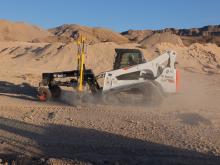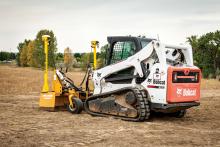The introduction of the latest version of
This now offers customers greater capabilities, due in many respects to its increased versatility, allowing users to capitalise on the telematics data produced by modern construction machines. According to Trimble, the previous generation VisionLink system worked very well with Caterpillar machines, due to the partnership between the firms. But this earlier package was only able to gather comparatively limited telematics data if used with machines from other manufacturers.
The latest package has benefited from broader changes within the construction machinery sector. New developments in the technology have been established between the different machine suppliers with the help of the equipment associations such as the
The latest version of VisionWorks has utilised this commonality so that there is now a unified tool that users can apply to review the maintenance and health of machines.
Jules Muir is product manager for productivity and telematics at Trimble and explained that the new VisionLink package is able to gather data from a wide range of machines, allowing users to merge this information for more effective fleet management. However, the sheer quantity of telematics data available should not swamp the user’s ability to process this. Rather, he said that the user needs data on actionable points without having to locate these manually. These action points are the issue for the customer and for example, while tracking fuel consumption may have some value, knowing when a machine will need refuelling is far more important.
However, presenting the machine data to the user is another key point. One customer approached Trimble as it wanted information available in different formats for different managers with different responsibilities. Muir said, “If they want a single view for everything, there is a way to do that.”
Muir said, “The main metrics for what the customer wants to choose are right there in front of them. You can build your own dashboard and overview in format.”
He explained that this data is available on demand and the user no longer has to drill through different menus and tables as this can be delivered in the format the customer needs. He said, “These dashboards are very configurable. It’s not one dashboard for everyone. Each person in an organisation can have the dashboard in the format they want.”
Muir explained that the system can even run on a mobile device such as a tablet or a smartphone, as a mobile app is available that is basically the same as the office system and features a unified interface.
Muir said that using this can deliver major gains in efficiency. “The system sets up trigger points with notifications in advance, such as if the machine needs refuelling or maintenance. The fleet managers will know this in advance so they can plan ahead and sidestep drops in utilisation.”
The VisionLink 2 package is a rework of the original system and features dedicated tools out of the box. Muir commented, “It’s about making the technology more accessible. One of the things we heard is that it’s not just a mixed fleet in one company. You’re bringing in rental machines or sub-contractors. The reality of construction is that it’s not simple. You need to manage information from different suppliers. “You don’t just need to recover data from the machines. You need to feed information back to the operators that they’re performing in a specific way.”
He said that there can be resistance from some machine operators, who may feel very wary of having, in effect, a digital spy in the cab. But if the user sets up a system in a certain way, operators can be encouraged to compete with each other for factors such as the best productivity or lowest cost/tonne for example. Tracking overall machine operation forms an essential component in improving overall construction efficiency.
Muir said, “It’s the only way you can manage construction and turn it into a manufacturing process.”
Trimble’s technology advances for machine fleets
Trimble is gearing up to boost construction efficiency with a new level of machine technology – Mike Woof writes
The introduction of the latest version of Trimble’s VisionLink package will help allow contractors to reduce operating costs while boosting working efficiency, according to the firm. Trimble’s VisionLink system was developed in partnership with Caterpillar and includes tools for production monitoring.
This now offers customers greater capabilities, due in many respects to its increased versat
Being able to access telematics data from all types of construction machines is a crucial step in delivering more efficient operations
Trimble is gearing up to boost construction efficiency with a new level of machine technology – Mike Woof writes







